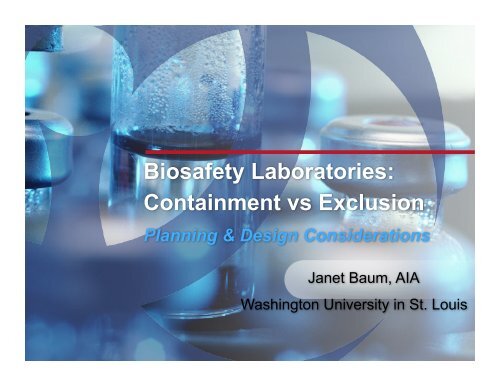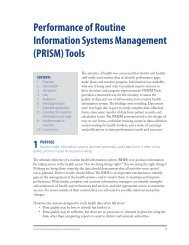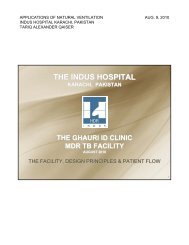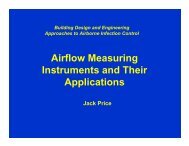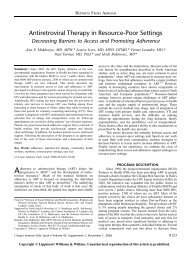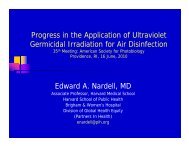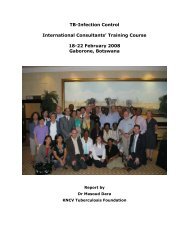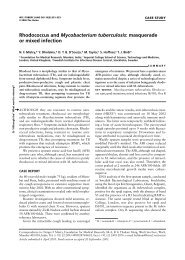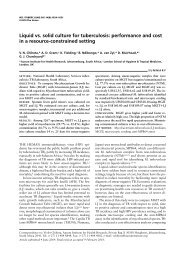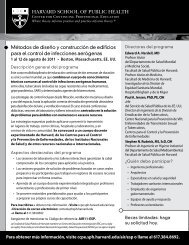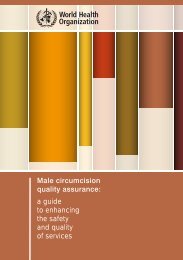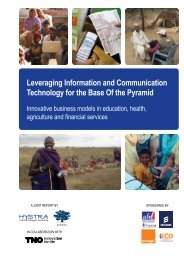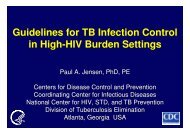Biosafety Laboratories: Containment vs Exclusion - Planning ...
Biosafety Laboratories: Containment vs Exclusion - Planning ...
Biosafety Laboratories: Containment vs Exclusion - Planning ...
You also want an ePaper? Increase the reach of your titles
YUMPU automatically turns print PDFs into web optimized ePapers that Google loves.
<strong>Biosafety</strong> <strong>Laboratories</strong>:<br />
<strong>Containment</strong> <strong>vs</strong> <strong>Exclusion</strong><br />
<strong>Planning</strong> & Design Considerations<br />
Janet Baum, AIA<br />
Washington University in St. Louis
<strong>Containment</strong> <strong>Laboratories</strong><br />
• Maintain under negative pressure to ALL<br />
surroundings<br />
• Treat effluent air<br />
• <strong>Biosafety</strong> Labs<br />
• High Toxicity Labs
<strong>Exclusion</strong> <strong>Laboratories</strong><br />
• Maintain under positive pressure to ALL<br />
surroundings<br />
• Treat supply air<br />
• Clean Room <strong>Laboratories</strong><br />
• Trace Analysis <strong>Laboratories</strong>
Neutral-Pressure <strong>Laboratories</strong><br />
• NO hazardous or toxic materials handled or<br />
stored<br />
• NO volatile or malodorous materials handled<br />
or stored<br />
• NO animals housed
<strong>Containment</strong> <strong>Laboratories</strong><br />
BIOSAFETY LABORATORY<br />
• Is a containment laboratory<br />
• U.S.A. <strong>Biosafety</strong> Levels are from 1 to 4<br />
• U.S.A. CDC / NIH designate hazard level of<br />
individual organisms on a scale of 1 to 4<br />
• U.S.A. Dept. of Agriculture designates hazard<br />
level of organisms on a scale of 1 to 3
U.S.A. Standards and Guidelines<br />
Biological Safety<br />
Centers for Disease Control with National Institutes of Health<br />
<strong>Biosafety</strong> in Microbiological and Biomedical <strong>Laboratories</strong><br />
U.S. Department of Agriculture<br />
Agricultural Research Service (ARS)<br />
Facility Design Standards<br />
Animal & Plant Health Inspection Service (APHIS)<br />
Quarantine Facility Guidelines for Microorganisms<br />
Quarantine Facility Guidelines for Weeds<br />
Quarantine Facility Guidelines for the Receipt and <strong>Containment</strong><br />
Non-indigenous Arthropod Herbivores, Parasitoids, Predators<br />
American Committee of Medical Entomology<br />
Arthropod <strong>Containment</strong> Guidelines
U.S.A. Standards and Guidelines<br />
Biological Safety<br />
National Institutes of Health<br />
Guidelines for Recombinant DNA Research<br />
Laboratory Safety Supplement to the Guidelines<br />
Occupational Safety and Health Administration<br />
Bloodborne Pathogens<br />
Tuberculosis Standard<br />
National Cancer Institute with NIH<br />
Guidelines for Oncogenic Viruses
International Standards & Guidelines<br />
Biological Safety<br />
• World Health Organization<br />
Laboratory Safety Guidelines<br />
• CEN (Comité Européen de Normalisation)<br />
CWA #15793 document, February, 2008,<br />
Laboratory Biorisk Management Standard<br />
• International Union Against Tuberculosis and Lung Disease<br />
1998 The Public Health Service National Tuberculosis<br />
Reference Laboratory Minimum Requirements,<br />
Role and Operation in a Low Income Country
U.S.A. Standards and Guidelines<br />
Impacting <strong>Biosafety</strong> <strong>Laboratories</strong><br />
AAALAC – Guide for Care and Use of Laboratory Animals<br />
Local Building Code<br />
National Building Code<br />
NFPA Standards<br />
Fire Protection Code<br />
Mechanical Code<br />
Plumbing Code<br />
Electrical Code<br />
Energy Code<br />
Nuclear Regulatory Commission<br />
OSHA<br />
Americans with Disabilities Act of 1990
U.S.A. Regulations<br />
U.S. Federal Laws<br />
Public Law 107- 56:<br />
U.S.A. Patriot Act of 2001 (Uniting and Strengthening America by<br />
Providing Appropriate Tools Required to Intercept and Obstruct Terrorism)<br />
Prohibits restricted persons from shipping, possessing, receiving select agents<br />
Public Law 107- 188:<br />
U.S.A. Public Health Security and Bioterrorism Preparedness<br />
and Response Act of 2002<br />
U.S.A. Agricultural Bioterrorism Protection Act of 2002<br />
Requires institutions to notify DHHS or USDA of possession of specific<br />
pathogens or toxins<br />
42 CFR Part 73 / Part 1003:<br />
U.S.A. Select Agent Act of 2002 (Possession, Use and Transfer of Select<br />
Agents and Toxins)<br />
(Department of Health and Human Services)
U.S.A. Regulations<br />
Select Agents<br />
U.S.A. Public Health Security and Bioterrorism Preparedness<br />
and Response Act of 2002<br />
Requires DHHS to regulate the possession, use, and transfer of biological<br />
agents or toxins that could pose a severe threat to public health and safety.<br />
DHHS require entities to register with the U.S. Centers for Disease Control<br />
U.S.A. Agricultural Bioterrorism Protection Act of 2002<br />
Requires USDA to regulate the possession, use, and transfer of biological<br />
agents or toxins that could pose a severe threat to animal or plant health<br />
or to animal or plant products. USDA require entities to register with APHIS.<br />
These Acts require establishment of a national database of registered entities<br />
Set criminal penalties for failing to comply with requirements of these Acts.<br />
CDC and APHIS coordinate regulatory activities for agents that would be<br />
Registered by both Agencies. The F.B.I. has been delegated authority for<br />
conducting security risk assessments.
U.S.A. Regulations<br />
CDC List of Select Agents<br />
Viruses Bacteria Fungi & Rickettsae Toxins<br />
• Hendra Virus -Equine<br />
Morbillivirus<br />
• Herpesvirus Simiae (B)<br />
• HPAI Influenza<br />
• 1918 Influenza<br />
• Arboviruse &<br />
Related Zoonotic<br />
Virus<br />
• Venezuelan Equine<br />
Encephalitis<br />
• Eastern Equine<br />
Encephalitis<br />
• Rift Valley Fever<br />
• Bacillus Anthracis<br />
• Burcella Abortus<br />
• Burkholderia Mallei<br />
• Burkholderia Pseudomallei<br />
• Neurotoxin Clostridium<br />
(Botulinum)<br />
• Francisella Tularensis<br />
• Coccidioides Immitis<br />
• Coxiella Burnetii<br />
• Rickettsia Prowazekii<br />
• Rickettsia Rickettsii<br />
• Abrin<br />
• Aflatoxins<br />
• Botulinum<br />
• Clostridium<br />
Perfringens Epsilon<br />
• Conotoxin<br />
• Diacetoxyscirpenol<br />
• Ricin<br />
• Saxitoxin<br />
• Sigatoxin<br />
• Staphylococcal<br />
Enterotoxin<br />
• Tetrodotoxin<br />
• T-2 Mycotoxin
U.S.A. Regulations<br />
CDC List of Bacterial Agents
U.S.A. Regulations<br />
CDC List of Viral Agents
U.S.A. Regulations<br />
CDC List of Other Agents
<strong>Biosafety</strong> Level 1 Laboratory (BSL-1)<br />
• Basic lab<br />
• Open bench operations<br />
• Standard lab practices<br />
• Operable windows have insect screens<br />
• <strong>Biosafety</strong> Cabinets (BSCs) not required<br />
• <strong>Biosafety</strong> cabinets should be used in introductory<br />
microbiology courses to teach students how to use<br />
BSCs.
<strong>Biosafety</strong> Level 2 Laboratory (BSL-2)<br />
in addition to all requirements for BSL-1<br />
• Basic lab<br />
• Limited access into lab<br />
• Biohazard warning signs<br />
• Lab coats and protective gloves used<br />
• Decontamination facility needed in building<br />
• <strong>Biosafety</strong> Cabinets are required when<br />
operations may produce aerosols<br />
• Negative pressure is achievable
Lab <strong>Planning</strong> Issues – BSL-2<br />
Agents<br />
Practices<br />
Safety Equipment<br />
(Primary Barriers)<br />
Facilities<br />
(Secondary Barriers)<br />
Suitable for<br />
work<br />
involving<br />
agents of<br />
moderate<br />
potential<br />
hazard to<br />
personnel<br />
and the<br />
environment<br />
BSL-1 plus:<br />
• Controlled<br />
access<br />
• Hand washing<br />
• Keep lab<br />
clothing within<br />
lab, do not wear<br />
outside lab<br />
• Baseline serum<br />
levels of staff<br />
• Needles / sharps<br />
precautions<br />
• Class II BSC’s or<br />
other physical<br />
containment<br />
devices used for<br />
all open<br />
manipulations of<br />
agents<br />
• PPE: protective<br />
gear as needed<br />
• Eyewash available<br />
• Sink for hand<br />
wash<br />
• Autoclave<br />
available<br />
BSL-1 plus:<br />
• Physical<br />
separation, &<br />
locked, selfclosing<br />
doors from<br />
access corridors<br />
• Sturdy, easily<br />
cleaned furniture<br />
and work surfaces<br />
• Exhausted air not<br />
recirculated<br />
• Negative airflow<br />
into laboratory<br />
• Insect screens on<br />
windows
Goals of a <strong>Containment</strong> Facility<br />
• Protect personnel in the laboratory<br />
• Provide productive scientific environment<br />
Liquid decon pass-thru<br />
– Protect research, samples, and products<br />
• Protect support staff who operate and maintain<br />
containment and ventilation systems/ controls<br />
• Protect environment<br />
– Surrounding personnel and functions<br />
– Outside environment, adjacent communities<br />
UV decon pass-thru pass-thru autoclave HEPA filter bank
Definition of a BSL-3 Facility<br />
Suitable for work with infectious agents which may cause<br />
serious or potentially lethal disease as a result of exposure by<br />
the inhalation route<br />
• Exposure potential to pathogens spread by aerosol<br />
• Infection serious, possibly lethal<br />
Canada National <strong>Biosafety</strong> Laboratory
<strong>Biosafety</strong> Level 3 Laboratory (BSL-3)<br />
in addition to all requirements for BSL-1 and BSL-2<br />
• Designed specifically for biological<br />
containment<br />
• Special protective clothing worn<br />
• All work with biological materials is in<br />
biosafety cabinets (BSCs)<br />
• Access is through two doors separated by an<br />
airlock that may be used for clothing change.
Lab <strong>Planning</strong> Issues – BSL-3<br />
Agents<br />
Practices<br />
Safety Equipment<br />
(Primary Barriers)<br />
Facilities<br />
(Secondary Barriers)<br />
Indigenous or<br />
exotic agents<br />
with potential<br />
for aerosol<br />
transmission;<br />
disease may<br />
have serious<br />
or lethal<br />
consequences<br />
BSL-2 plus:<br />
• Controlled<br />
access<br />
• Work in certified<br />
BSC<br />
• Decontamination<br />
of all waste<br />
• Decontaminate<br />
lab clothing<br />
before laundering<br />
• Baseline serum<br />
levels of staff<br />
• Class II or III BSC’s<br />
or other physical<br />
containment<br />
devices used for all<br />
open manipulations<br />
of agents<br />
• PPE: protective lab<br />
clothing, gloves,<br />
respiratory<br />
protection as<br />
needed<br />
• Autoclave in lab<br />
suite<br />
• HEPA filter vacuum<br />
lines<br />
BSL-2 plus:<br />
• Physical separation<br />
from access<br />
corridors<br />
• Locked self-closing,<br />
double-door access<br />
• Exhausted air not<br />
recirculated<br />
• Negative airflow into<br />
laboratory<br />
• Room penetrations<br />
are sealed<br />
• Room surfaces are<br />
water resistant for<br />
cleaning
<strong>Biosafety</strong> Level 3 Lab – ABSL-3<br />
in addition to all requirements for BSL-1, BSL-2, BSL-3<br />
• Designed specifically for biological<br />
containment of small research animals<br />
• Entrance is through a pressure-controlled<br />
airlock used for clothing change.<br />
• Exit optional through an airlock used for<br />
personnel showers and clothing change.<br />
• Supply and exhaust systems separate and<br />
independent of other building ventilation.<br />
• Interlocked controls to maintain pre-set<br />
pressures
<strong>Biosafety</strong> Level 3 Lab – BSL-3Ag<br />
in addition to all requirements for BSL-1, BSL-2, BSL-3<br />
• Designed specifically for biological<br />
containment of plants and large animals<br />
• Entrance is through a pressure-controlled<br />
airlock used for clothing change.<br />
• Exit is through an airlock used for personnel<br />
showers and clothing change.<br />
• Supply and exhaust systems separate and<br />
independent of other building ventilation.<br />
• Interlocked controls to maintain pre-set<br />
pressures
<strong>Biosafety</strong> Level 4 Laboratory (BSL-4)<br />
in addition to all requirements for BSL-1, BSL-2, BSL-3<br />
• Designed specifically for biological<br />
containment.<br />
• Entrance is through a pressure-controlled<br />
airlock used for clothing change.<br />
• Exit is through an airlock used for personnel<br />
showers and clothing change.<br />
• Total containment Class III biosafety cabinets<br />
or<br />
• Partial containment Class II biosafety<br />
cabinets used by personnel clothed in<br />
positive-pressure, full-body, suits with<br />
separate and protected air supply
<strong>Biosafety</strong> Level 4 Laboratory (BSL-4)<br />
in addition to all requirements for BSL-1, BSL-2, BSL-3<br />
• Supply and exhaust systems separate and<br />
independent of other building ventilation.<br />
• Interlocked controls to maintain pre-set<br />
pressures<br />
• HEPA filtered supply air<br />
• Dual HEPA filtered exhaust air, in sequence<br />
• In-place filter testing facilities
Cost Premium-<strong>Containment</strong> Facilities
Cost Premium-<strong>Containment</strong> Facilities
Cost Premium-<strong>Containment</strong> Facilities<br />
Diagram of BSL-4 <strong>Containment</strong> Concept
<strong>Containment</strong> <strong>Planning</strong> – BSL-3 and 4<br />
Primary/Secondary<br />
Barriers<br />
Camera<br />
Bubble<br />
Air<br />
Supply<br />
Diffuser<br />
Breathing<br />
Air<br />
<strong>Biosafety</strong> cabinets used<br />
Gas tight room tested<br />
and certified<br />
Air Locks with air<br />
pressure doors<br />
Electrical<br />
Outlets<br />
Floor/Sink<br />
Drains<br />
Window<br />
Frame<br />
Waste Management<br />
All waste rendered harmless<br />
autoclave waste from lab<br />
decontaminate effluent waste<br />
HEPA filter air
<strong>Containment</strong> <strong>Planning</strong> – BSL-3 and 4<br />
• Design of containment barriers<br />
• Quality research = containment<br />
• Ventilation requirements<br />
Sealed pipe penetrations<br />
BSL-3 lab in Canada
<strong>Containment</strong> <strong>Planning</strong> – BSL-3 and 4<br />
<strong>Containment</strong> Barriers<br />
• Primary barrier<br />
– Biological safety cabinet<br />
– Personal protective gear<br />
• Secondary barrier<br />
– Room enclosure<br />
– Engineering systems<br />
• Tertiary barrier<br />
– Building around lab<br />
– <strong>Containment</strong> around<br />
systems<br />
BSL-3 lab in Canada
Concentrate/ Minimize – BSL-3 and 4<br />
• Limit number of individuals and processes that<br />
must work under BSL-3 and BSL-4 conditions<br />
• Provide appropriate service support outside<br />
containment zone<br />
• Provide adequate functional support inside<br />
containment zone<br />
• Estimate capital and life cycle costs for operating<br />
facility<br />
Capital cost includes design, construction, commissioning,<br />
and equipment fit-out of the laboratory<br />
Life cycle cost includes utility expense for ventilation and<br />
electric power, filter testing / replacement, inspections,<br />
insurance / liability
Plan for Flexibility<br />
• Regulatory and research changes<br />
• New pathogens<br />
• New equipment
<strong>Planning</strong> Concepts – BSL-3 and 4<br />
• Hazard zoning<br />
• Egress in direction of lower hazard<br />
• Zone from clean to dirty<br />
• Separate hazards that may interact<br />
• Isolate highest hazard processes & agents<br />
Enter<br />
Exit<br />
Prep Lab<br />
Air Flow<br />
Hazard<br />
Contaminated<br />
Hot Zone<br />
Lowest Hazard<br />
Highest Hazard
<strong>Planning</strong> Concepts – BSL-3 and 4<br />
• One-way passage<br />
• Enter BSL-3 lab from one passage, exit from<br />
another<br />
• Sequential work flow, if possible<br />
• Reduce intersections in circulation pathways<br />
Process<br />
Path<br />
ENTRY<br />
Process<br />
#1<br />
Process<br />
#2<br />
Process<br />
#3<br />
EXIT<br />
Process<br />
#5<br />
Process<br />
#4
<strong>Planning</strong> Concepts – BSL-3 and 4<br />
• Suites<br />
• Cluster support<br />
functions around<br />
basic work zone to<br />
reduce distances<br />
between functional<br />
zones<br />
• Good for repetitive<br />
functions and<br />
processes<br />
Decon<br />
Entry<br />
Vestibule<br />
Specimen<br />
Drop-off<br />
Equipment<br />
BSL-3<br />
Solutions/<br />
Media Prep<br />
Culture<br />
Labs
<strong>Planning</strong> Concepts – BSL-3<br />
Graphic Program<br />
Blocking Diagram<br />
AL<br />
BSL-2<br />
AL<br />
AL<br />
Micro<br />
Test<br />
Decon<br />
BSL-3 Cell<br />
Culture<br />
BSL-3<br />
Cell<br />
Culture<br />
Degown<br />
BSL-2<br />
Degown /<br />
Shower<br />
Gown<br />
AL<br />
AL<br />
BSL-3<br />
Gown<br />
Decon
<strong>Planning</strong> Concepts – BSL-3<br />
Flow Diagram<br />
AL<br />
Micro<br />
Test<br />
Decon<br />
BSL-3 Cell<br />
Culture<br />
BSL-2<br />
Degown<br />
AL<br />
BSL-3<br />
Gown<br />
AL<br />
Personnel Supplies<br />
Infectious Agent / Waste Material<br />
Animals
<strong>Planning</strong> Concepts – BSL-3 and 4<br />
• Locate biosafety cabinets and fume hoods<br />
out of high traffic zones<br />
• Develop understanding on how to deal with<br />
emergencies within containment zone<br />
• Understand how to manage emergencies<br />
from outside zone<br />
• Investigate how containment zone can<br />
expand in future, if needed
<strong>Planning</strong> Concepts – BSL-3<br />
Primary Entry<br />
and Exit<br />
Emergency Exit<br />
Only<br />
Phones<br />
Phones<br />
BSC BSC BSC<br />
EQ<br />
FH<br />
Bench<br />
EQ<br />
EQ<br />
EQ<br />
AL<br />
Air<br />
Locks<br />
BSC<br />
Degown<br />
& Gown<br />
Micro<br />
Test<br />
AC<br />
AC<br />
Shower<br />
Air<br />
Locks<br />
Decon<br />
EQ<br />
Bench<br />
Cell<br />
Culture<br />
EQ<br />
BSC<br />
BSC<br />
BSC BSC<br />
BSL-2<br />
BSL-3
<strong>Planning</strong> Concepts – BSL-3<br />
Expansion Options<br />
Emergency Exit<br />
Only<br />
Primary Entry<br />
and Exit<br />
Emergency Exit<br />
Only<br />
Phones<br />
Phones<br />
Phones<br />
BSC<br />
Cell<br />
Culture<br />
Decon<br />
AC<br />
AC<br />
Micro<br />
Test<br />
BSC<br />
EQ<br />
AL<br />
BSC<br />
Micro<br />
Test<br />
AC<br />
AC<br />
Decon<br />
Cell<br />
Culture<br />
BSC<br />
Bench<br />
or<br />
Equip<br />
BSC<br />
BSC<br />
BSC<br />
BSC<br />
EQ<br />
Shower<br />
AL<br />
Air<br />
Lock<br />
Degown<br />
& Gown<br />
EQ<br />
Bench<br />
FH EQ<br />
EQ<br />
Air<br />
Lock<br />
Degown<br />
& Gown<br />
Shower<br />
AL<br />
EQ<br />
Bench<br />
or<br />
Equip<br />
EQ<br />
BSC<br />
BSC BSC<br />
BSL-3<br />
BSL-2<br />
BSL-3
<strong>Planning</strong> Concepts – BSL-3<br />
Expansion Options<br />
Primary Entry<br />
and Exit<br />
Emergency Exit<br />
Only<br />
Phones<br />
Phones<br />
BSC BSC BSC<br />
Bench<br />
EQ<br />
AL<br />
Air<br />
Lock<br />
BSC<br />
Micro<br />
Test<br />
AC<br />
AC<br />
Shower<br />
Decon<br />
Bench<br />
Equip<br />
Or BSC<br />
Equip<br />
Decon<br />
BSC BSC<br />
EQ EQ<br />
EQ BSC<br />
Cell Culture<br />
EQ BSC<br />
EQ<br />
FH<br />
EQ<br />
EQ<br />
Degown<br />
& Gown<br />
AL<br />
EQ<br />
EQ<br />
BSC<br />
EQ<br />
EQ<br />
BSC<br />
BSL-2<br />
BSL-3
Design Concepts – BSL-3 and 4<br />
• Understand how laboratory can be cleaned<br />
– Shape of each space is simple (minimize corners)<br />
– Finishes are seamless, smooth and coved<br />
– Seal ALL penetrations through interior surfaces,<br />
walls, floors, and ceilings<br />
– Conduct Integrated Pest Management Program<br />
– Equipment is located so floor can be cleaned;<br />
provide clearances above, below and beside them<br />
enough for mop and head of shop-vacuum machine<br />
– Provide cleaning tools and supplies within lab for<br />
daily as well as emergency cleaning procedures
Design Concepts – BSL-3 and 4<br />
• Understand how laboratory and equipment<br />
can be maintained<br />
– Provide tools for simple repairs<br />
– Locate laboratory HVAC controls exterior to<br />
laboratory so maintenance staff do not have to<br />
enter containment zone to do tests and repairs<br />
– Locate HVAC dampers and actuators exterior to<br />
laboratory so maintenance staff do not enter<br />
– Clearances above, below and beside adequate<br />
for access to controls motors, fans, filters.
Design Concepts – BSL-3 and 4<br />
• Understand overall health & safety issues<br />
– Perform periodic risk assessments<br />
– Personnel Medical Surveillance Program<br />
– Ergonomics<br />
– Visibility to all parts of lab<br />
– Communications – internal and external<br />
– Alarm systems – internal and external<br />
– Safety equipment located in critical areas<br />
– Back-up systems for PPE, critical supplies
Design Concepts – TB Testing Labs<br />
• In developing countries 3 types of labs<br />
supported by W.H.O. and other NGOs<br />
– Peripheral <strong>Laboratories</strong> in rural regions, villages<br />
for initial TB screening from sputum samples<br />
– Intermediate <strong>Laboratories</strong> in towns and cities<br />
for initial TB screening and confirmation of<br />
samples brought from Peripheral <strong>Laboratories</strong><br />
– Central <strong>Laboratories</strong> capitol of nation or region<br />
for initial TB screening, confirmation of samples<br />
brought from Intermediate <strong>Laboratories</strong>, and<br />
testing for MDR and XDR TB
Design Concepts – WHO Level 3<br />
PERIPHERAL LABORATORY 1
Design Concepts – WHO Level 3<br />
PERIPHERAL LABORATORY 1
Design Concepts – WHO Level 3<br />
PERIPHERAL LABORATORY 1<br />
STORAGE<br />
CABINETS<br />
LOG-IN<br />
TABLE<br />
WET<br />
BENCH<br />
HAND<br />
WASH<br />
SINK<br />
REF<br />
MICROSCOPE &<br />
WORK TABLES
Design Concepts – WHO Level 3<br />
PERIPHERAL LABORATORY 2
Design Concepts – WHO Level 3<br />
PERIPHERAL LABORATORY 2
Design Concepts – WHO Level 3<br />
PERIPHERAL LABORATORY 2<br />
STORAGE<br />
CABINETS<br />
LAB<br />
ENTRY<br />
LOG-IN<br />
TABLE<br />
HAND<br />
WASH<br />
SINK<br />
WORK TABLE &<br />
STORAGE CABINET<br />
REF<br />
WET<br />
BENCH<br />
MICROSCOPE &<br />
WORK TABLES &<br />
STORAGE CABINET
Design Concepts – WHO Level 3<br />
PERIPHERAL LABORATORY 1
Design Concepts – WHO Level 3<br />
INTERMEDIATE LABORATORY 1
Design Concepts – WHO Level 3<br />
INTERMEDIATE LABORATORY 1<br />
PPE ANTEROOM<br />
SPUTUM RECEIVING<br />
& LOG-IN
Design Concepts – WHO Level 3<br />
INTERMEDIATE LABORATORY 1<br />
PPE ANTEROOM<br />
SPUTUM RECEIVING<br />
& LOG-IN<br />
LAB<br />
ENTRY<br />
LOG-IN<br />
TABLE<br />
PASS-THRU<br />
BOX<br />
MAIN<br />
ENTRY<br />
STORAGE<br />
CABINET<br />
PASS-THRU<br />
BOX<br />
HAND<br />
WASH<br />
SINK
Design Concepts – WHO Level 3<br />
INTERMEDIATE LABORATORY 1<br />
CULTURE LAB<br />
INCUBATION<br />
LAB
Design Concepts – WHO Level 3<br />
INTERMEDIATE LABORATORY 1<br />
BSC<br />
CULTURE LAB<br />
CENTRI<br />
-FUGE<br />
LAB<br />
ENTRY<br />
REF<br />
WET<br />
BENCH<br />
HAND<br />
WASH<br />
SINK<br />
LAB<br />
ENTRY<br />
INCUBATION<br />
LAB<br />
STORAGE<br />
SHELVES<br />
PASS-<br />
THRU<br />
BOX &<br />
TABLE<br />
MICROSCOPE<br />
TABLES<br />
STORAGE<br />
SHELVES
Design Concepts – WHO Level 3<br />
INTERMEDIATE LABORATORY 1<br />
STERILIZATION<br />
LAB<br />
MEDIA & REAGENT<br />
PREP LAB
Design Concepts – WHO Level 3<br />
INTERMEDIATE LABORATORY 1<br />
MEDIA & REAGENT<br />
PREP LAB<br />
PASS-THRU<br />
AUTOCLAVE<br />
LAB<br />
ENTRY<br />
STORAGE<br />
CABINET<br />
STERILIZATION<br />
LAB<br />
HAND<br />
WASH<br />
SINK<br />
PASS-THRU<br />
AUTOCLAVE<br />
STORAGE<br />
CABINET<br />
REF<br />
PASS-<br />
THRU<br />
BOX &<br />
TABLE<br />
WET<br />
BENCH<br />
WET<br />
BENCH
Design Concepts – WHO Level 3<br />
INTERMEDIATE LABORATORY 1<br />
Mechanical Ventilation Zone<br />
51 SM or 550 SF
Design Concepts – WHO Level 3<br />
INTERMEDIATE LABORATORY 1<br />
Natural Ventilation Zone<br />
24 SM or 258.0 SF<br />
Prevailing<br />
Winds<br />
Mechanical Ventilation Zone<br />
51 SM or 550 SF
Design Concepts – WHO Level 3<br />
CENTRAL LABORATORY 1<br />
For COLD CLIMATES
Design Concepts – WHO Level 3<br />
CENTRAL LABORATORY 1<br />
For WARM CLIMATES
Design Concepts – WHO Level 3<br />
CENTRAL LABORATORY 1<br />
MDR TESTING<br />
LAB<br />
CULTURE LAB
Design Concepts – WHO Level 3<br />
CULTURE LAB<br />
CENTRAL LABORATORY 1<br />
MDR TESTING<br />
LAB<br />
BSC<br />
MICROSCOPE<br />
TABLES<br />
BSC<br />
BSC<br />
WET<br />
BENCH<br />
WET<br />
BENCH<br />
HAND<br />
WASH<br />
SINK<br />
PASS-<br />
THRU<br />
BOX &<br />
TABLE<br />
HAND<br />
WASH<br />
SINK<br />
MICROSCOPE<br />
TABLES
Design Concepts – WHO Level 3<br />
CENTRAL LABORATORY 2
Design Concepts – WHO Level 3<br />
WAITING ROOM<br />
CENTRAL LABORATORY 2<br />
RECEIVING<br />
ROOM
Design Concepts – WHO Level 3<br />
WAITING ROOM<br />
CENTRAL LABORATORY 2<br />
PASS-<br />
THRU<br />
BOX<br />
LAB<br />
ENTRY<br />
HAND<br />
WASH<br />
SINK<br />
HAND<br />
WASH<br />
SINK<br />
LAB<br />
ENTRY<br />
PASS-<br />
THRU<br />
BOX &<br />
TABLE<br />
RECEIVING<br />
LAB<br />
DESKS or<br />
TABLES<br />
STORAGE<br />
CABINETS
Design Concepts – WHO Level 3<br />
MDR TESTING LAB<br />
CENTRAL LABORATORY 2
Design Concepts – WHO Level 3<br />
CENTRAL LABORATORY 2<br />
MDR TESTING LAB<br />
LAB<br />
ENTRY<br />
HAND<br />
WASH<br />
SINK<br />
LAB<br />
SINK<br />
LAB<br />
TABLES<br />
PASS-<br />
THRU<br />
BOX<br />
BSC<br />
WET<br />
BENCH<br />
BSC<br />
MICROSCOPE<br />
TABLE
Design Concepts – WHO Level 3<br />
PCR AMPLIFICATION<br />
LAB<br />
CENTRAL LABORATORY 2<br />
STEP 2<br />
DNA SEQUENCING<br />
LAB<br />
DNA EXTRACTION<br />
LAB<br />
STEP 1<br />
STEP 3
Design Concepts – WHO Level 3<br />
DNA EXTRACTION<br />
LAB<br />
PASS-<br />
THRU<br />
BOX<br />
PCR AMPLIFICATION<br />
LAB<br />
HAND<br />
WASH<br />
SINK<br />
COMPUTER<br />
TABLE<br />
HAND<br />
WASH<br />
SINK<br />
BSC<br />
WET<br />
BENCH<br />
CENTRAL LABORATORY 2<br />
LAB<br />
ENTRY<br />
EQUIPMENT<br />
BENCH<br />
2 PASS-THRU<br />
TRANSFER<br />
BOXES<br />
EQUIPMENT<br />
TABLES<br />
WET<br />
BENCH<br />
DNA SEQUENCING<br />
LAB<br />
PASS-<br />
THRU<br />
BOX<br />
REF<br />
LAB<br />
ENTRY<br />
HAND<br />
WASH<br />
SINK
<strong>Biosafety</strong> <strong>Laboratories</strong>:<br />
<strong>Containment</strong> <strong>vs</strong> <strong>Exclusion</strong><br />
<strong>Planning</strong> & Design Considerations<br />
Janet Baum, AIA<br />
Washington University in St. Louis


